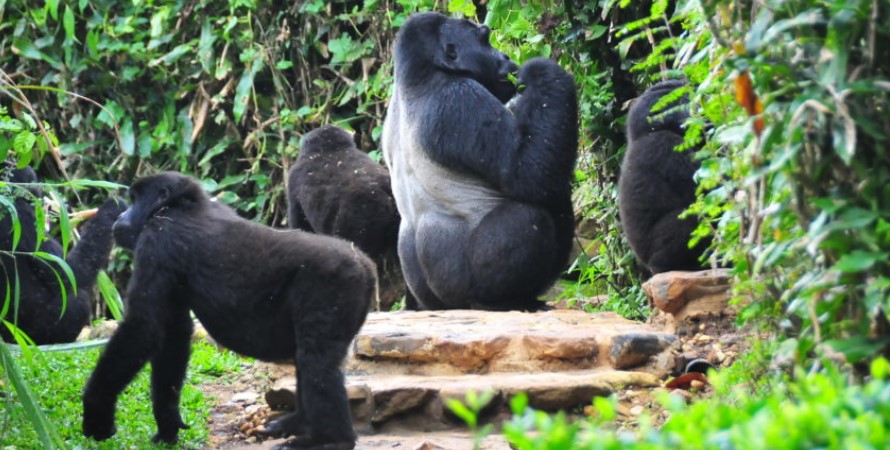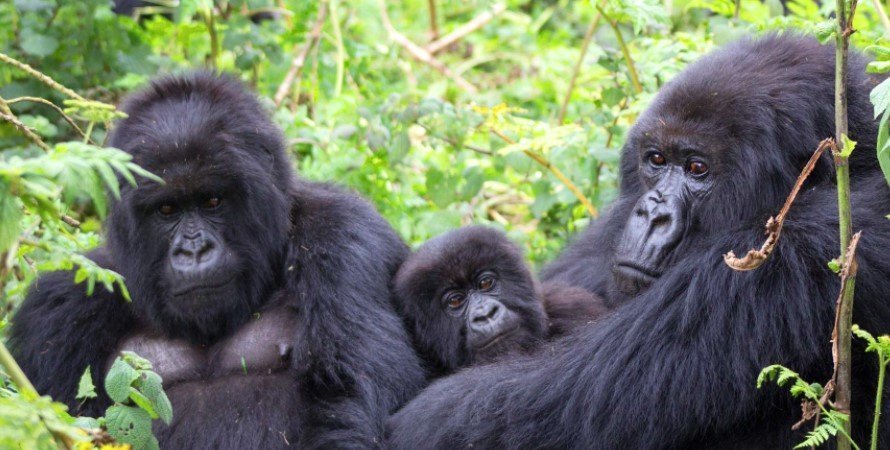Gorilla Families In Rushaga Sector
Gorilla families in Rushaga sector: The endangered mountain gorillas are found in this sector of the Bwindi Impenetrable National Park. The most popular gorilla location in Uganda, Bwindi Impenetrable National Park, is located in the Southern region of Rushaga Sector. Situated in the Southwestern region, Bwindi Impenetrable National Park is renowned for being home to the greatest population of mountain gorillas. Eight habituated mountain gorilla families reside in the Rushaga region and are accessible for daily trekking. The only area of the Bwindi Impenetrable National Park that provides gorilla habituation—a process in which wild mountain gorillas are trained to get accustomed to human presence in preparation for trekking—is the Rushaga sector. In the Bwindi Impenetrable National Park, there are additional gorilla trekking sectors located in the Northeastern Buhoma sector, the Eastern Ruhija sector, and the Southern Nkuringo sector.Families of gorillas in Rushaga area
The Nshongi gorilla family The Nshongi gorilla family, which is found in the Rushaga area, gets its name from the Nshongi River, where it was initially observed. The river was given the name Nshongi, which means Omushongi Gwoboki in the native tongue, because the water in it has a honey-like appearance. Trekking to the Nshongi gorilla family began in September 2009 after they were habituated in 2007. With 10 members, the Silverback Mishaya split out from the Nshongi group in 2010 to start his own family, leaving the group with 26 members. The Bweza group split off from the Nshongi Gorilla family in 2013, and as of right now, there are seven members remaining.
The Mishaya gorilla family One of the gorilla families in the Rushaga sector that is accessible for hiking is Mishaya. Tinfayo, a dominant silverback gorilla, is the head of the gorilla family. Following a struggle between the dominant silverback in the Nshongi group and the Mishaya silverback, the Mishaya gorilla family split off from the Nshongi family. Ten gorillas, including the silverback Mishaya, joined the group when it was founded in 2010 and passed away on February 3, 2014, from intestinal blockage. Lacking an adult male to command the group, several members of the Mishaya silverback family joined other gorilla groups, such as Bweza and Bikingi. The dominant silverback Tinfayo, who was formerly a member of the Shongi family and left the family in 2012 with an adult female named Shida and an infant named Rotary, was found by park officials in May 2018 as part of the Mishaya gorilla family. There are presently 8 members of the Mishaya gorilla family: 1 silverback, 5 adult females, 1 juvenile, and 1 newborn.
Family of Kahungye gorillas The Rushaga sector’s Kahungye gorilla family got its name from the Kahungye hill where it was initially observed. The Kahungye gorilla family began to acclimate in 2009, and trekking began in 2011. There were 27 gorillas in the family at the time of habituation, and Ruhemuka Silverback was the leader until March 2013, when he suffered a brain injury after falling from a tree. He had severe bleeding in his brain from the fall, and park rangers discovered him dead. Afterwards, the Kahungye gorilla group split into two and became the Busingye group, leaving Kahungye with 17 members. There are presently 13 gorillas in the family, led by the subservient Rumanzi and the dominating silverback Gwigi.
Family of Busingye gorillas In the Rushaga sector is another gorilla family called Busingye. In 2012, the family split away from the Kahungye gorilla family and adopted the name Busingye in honor of the dominant silverback. The gorilla family, which consists of nine members—one silverback, one black back, three adult females, two juniors, and three infants—is well-known for foraging in the park’s interior regions.
The Bweza family of gorillas Another family of gorillas in the Rushaga sector is called Bweza. The dominant silverback Bweza, who split off from the Nshongi gorilla family in 2012 to form his own group, is the reason the gorilla family got its name. There are presently 12 members of the Bweza gorilla family: 2 silverbacks, 3 adult females, 1 subadult female, 4 black backs, and 2 newborns.

Family of Bikingi gorillas Another family of gorillas in the Rushaga sector is the Bikingi gorilla family. The Bikingi gorilla troop began to become habituated in 2012. Its name comes from Bikingi Silverback, one of the group’s former prominent leaders. Following a confrontation with a lone male, Biking Silverback died. The other members scattered, with some joining other gangs such as Kahungye. The 12 members of the Bikingi gorilla family are 2 silverbacks, 5 adult females, 1 juvenile, and 4 newborns.
The family of Rwigi gorillas One of the newest gorilla groups in the Rushaga sector is Rwigi. After the gorilla group split from the Kahunge family, Rwigi the silverback and a dominant silverback in the Kahunge group had a disagreement. The Rwigi gorilla family, which consists of 10 members—1 silverback, 5 females, 2 juniors, and 2 babies—was named after the dominant Rwigi silverback.
Mucunguzi family of gorillas In the Bwindi Impenetrable National Park’s Rushaga Sector, there is another family of gorillas called Mucunguzi. The gorilla family gets its name from a silverback known locally as Mucunguzi, which means savior. The Bweza family and the gorilla family split apart, and at the time of habituation, Mucunguzi, the youngest member of the Bweza family who had earlier been chased after a fight, was leading the gorilla group. The Mucunguzi gorilla family consists of twelve individuals.

Experience trekking with gorillas in the Rushaga region At the park headquarters, gorilla trekking in the Rushaga area begins very early in the morning with a briefing on the rules and regulations that must be followed. You will be split up into groups of eight after the briefing, and each group will be paired with a habituated gorilla family to travel with and an experienced park guide who is knowledgeable about the gorilla trekking routes. Due to their tendency to roam around in quest of food, mountain gorilla trekking in the Rushaga sector can take anywhere from two to seven hours, depending on the gorillas’ exact location. After the mountain gorillas are located, you will have the opportunity to spend an hour in their natural environment where you can observe and learn about their daily routines, including feeding, playing, caring for their young, and taking pictures and videos to share with loved ones back home.
The ideal time to walk with gorillas in the Rushaga region Although gorilla trekking in the Rushaga sector can be done year-round, the best time to go is in the dry season, which falls in the months of June, July, August, September, December, January, and February. During this time, the park experiences less rainfall, which results in shorter vegetation that gives visitors clear views of the mountain gorillas. Additionally, the access roads and gorilla trekking trails are dry and passable, making trekking easier.
The price of a permit to trek gorillas in the Rushaga region In the Rushaga region of Bwindi Impenetrable National Park, a gorilla trekking permit costs 700 USD for non-resident foreigners, 600 USD for residents, and 250,000 UGX for citizens of East Africa.
How to reach the sector of Rushaga The Rushaga sector is reachable by road transport; visitors drive from Kampala via Masaka, Mbarara, and Kabale before arriving in the sector, which takes approximately eight to nine hours to reach in a 4WD safari vehicle. Rushaga sector is situated in the Southern portion of Bwindi Impenetrable National Park.
Travelers can also reach the Rushaga sector by air. To get to Kisoro airstrip, which is connected to the park headquarters by road, they can arrange scheduled or charter domestic flights with Budget Gorilla Trekking from Entebbe international airport or Kajjansi airfield.
It is also possible to reach the Rushaga sector from Kigali, Rwanda. From there, passengers can drive for four to five hours to reach the Cyanika border in Kisoro or the Katuna border in Kabale.
For additional information about gorilla families in the Rushaga sector, get in touch with Budget Gorilla Trekking, or visit our website to reserve a reasonably priced gorilla safari trip with us.



